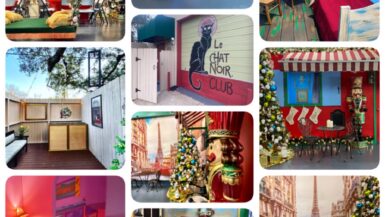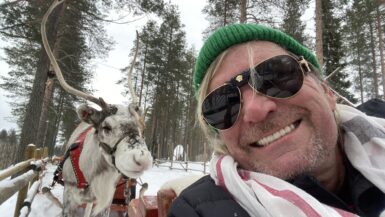I was standing on the top of the Eiffel Tower yesterday looking down at all the Christmas lights scattered throughout Paris. In spite of the recent tragedy, the French seemed to have taken the “Whoville” approach to dealing with the holidays. Nothing can stop Christmas from coming. Security is a little more obvious than it used to be, but the season is still in full swing. When you think of France, Christmas probably isn’t usually the first thing that enters your mind, but Strasbourg in the northeastern part of the country invented the Marche Noel or Christmas market in 1570 AD and we’ve been shopping ever since! The French started some of our earliest traditions and if you want to catch the Christmas spirit, this is definitely the place to get started.
The Alsace region in the eastern part of France has changed hands a few times between the French and Germans but it’s one of the beautiful places in France to visit during the holidays as it combines the best of the both Christmas traditions. Where else can you find pretzels and foie gras under the same roof? One of the things that many Americans yearn for is tradition. Our oldest cities are toddlers compared to the age of the French medieval cities that line the Rhine River. Our cities are hundreds of years old. Theirs are thousands. The ancient buildings in these medieval towns create the perfect frame for the magical Christmas paradise the townspeople produce each year. About the time we’re celebrating Thanksgiving, the cities start transforming their open squares into special outdoor malls with portable timber buildings, fir trees, lights, and even ice skating rinks and rides.
Each little chalet is decorated, illuminated and sells seasonal treats, ornaments, hats, toys and regional delicacies.These buildings are temporary, but the facades on many of them are cheerfully decorated with holiday themes to make them appear like gingerbread houses or cute little cottages that look like they belong exactly where they are. As you walk between them, you can smell the cheese covered pretzels, the freshly made crepes drizzled with Nutella and the vin de chaud. Vin de chaud translated is literally “hot wine” and it comes in a choice of red or the area’s specialty white. The wine is mixed with cinammon, sugar, spices and heated in a big pot ladled out to the anxious customers. If that doesn’t warm you up enough, you can walk over to the portable grills of roasting chestnuts. Yes,chestnuts roasting o’er an open fire; just like the song. Have you ever seen that? Every American knows the song, but I’m guessing that most of us have never tried a chestnut. Let me take that back. I have. I don’t recommend them. The song makes them sound better than they taste.
Metz is a few hours west of Strasbourg and has the distinction of being the second largest Marche Noel in France. It’s actually several markets scattered throughout the town and connected to the shopping areas. Until my visit there, I had ever seen Christmas themed rides; There was a giant mechanical tree with whirling ornaments and a snowman ticket booth ; a giant inflatable snow globe complete with a life sized Santa and an airlock door allowing visitors to be in the globe. How fun is that? Disney Paris was sponsoring an ice sculpture tent attraction with amazing hand carved 3D frozen creations of Disney scenes and characters, an ice slide and an ice bar serving hot chocolate and vin de chaud. As you walk between the sculptures, you have to marvel at the skills of the artists that labored on the icy statues for over a month in freezing temperatures created in the tent to keep the ice from melting. The town is a winter wonderland. It’s amazing cathedral and train station mix perfectly with the Christmas decor and giant lit trees to produce something unbelievably beautiful. A giant Ferris wheel takes guests above the roof of the ancient church
South of Strasbourg is a string of small towns, each with something unique to offer in their Christmas markets. The tiny town of Eguisheim has been voted as one of the most beautiful villages in France for years. Stroll around the square or take the rampart path around the entire city (it takes about 30 minutes) and you’ll feel like you’re in a giant Christmas decoration. It’s so perfect, it’s almost not even real. It’s the type of town you see in Christmas cards and wonder where someone found a real town that actually looks like that. A little further north is the medieval town of Riquewihr. The walled city is amazing and you can’t help but think that this is the kind of place that Pinocchio might live or where fairy tales actually occur. This tiny town has been discovered long ago by the tour companies and you’ll definitely be battling crowds. It is beautiful, traditional and the old houses and alleyways are a photographer’s dream. Sample the local choucroute, the French answer to sauerkraut, served hot with assorted meats.
You could easily spend a week visiting the little towns along the Rhine river and discovering the secrets of each one of them. As you travel the Alsace wine trail, as this region is also called, one of the highlights of the area is the gingerbread factory in the tiny town of Gerwiller. Is it touristy? Yes. Gingerbread has been historically connected to Christmas for hundreds of years and as kitschy as your visit to this factory/store might seem, you can’t help but be amazed at the culinary creations that have been produced in these ovens for over 200 years. As soon as you enter the shop and see the thousands of sweet goody choices, you’ll start thinking of what you can cram in your suitcase. Next door, the factory offers a interactive tour where you can see cute decorative sets, a short history of gingerbread, gingerbread art and some of the factory workers in action cutting out gingerbread men.
Should you be afraid of France? Absolutely not. Christmas is a great time to visit and with tourism down because of the unfortunate Paris tragedy, hotel owners and tourist offices are delighted to have your business. You won’t have to contend with the normal crowds that overwhelm the little villages and the French are extremely appreciative of your support.






Leave a reply
You must be logged in to post a comment.